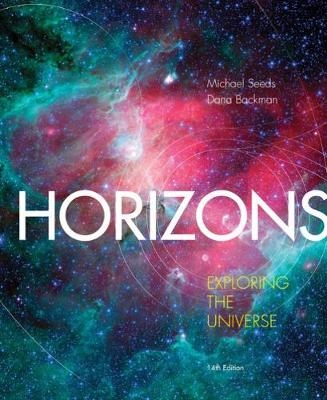
Horizons: Exploring the Universe
Brooks/Cole (Verlag)
978-1-305-96096-1 (ISBN)
- Lieferbar
- Versandkostenfrei
- Auch auf Rechnung
- Artikel merken
Mike Seeds was a professor of physics and astronomy at Franklin and Marshall College (F&M) in Lancaster, Pennsylvania, from 1970 until his retirement in 2001. In 1989 he received F&M College’s Lindback Award for Distinguished Teaching. Mike’s love for the history of astronomy led him to create upper-level courses on archeoastronomy and on the Copernican Revolution (“Changing Concepts of the Universe”). His research interests focused on variable stars and automation of astronomical telescopes. Mike is coauthor with Dana Backman of FOUNDATIONS OF ASTRONOMY, 14th Edition (2019); STARS AND GALXIES, 10th Edition (2019); THE SOLAR SYSTEM, 10th Edition (2019); and ASTRO, 3rd Edition (2018), all published by Cengage. He was senior consultant for creation of the 20-episode telecourse accompanying his book HORIZONS: EXPLORING THE UNIVERSE. Mike Seeds was a professor of physics and astronomy at Franklin and Marshall College (F&M) in Lancaster, Pennsylvania, from 1970 until his retirement in 2001. In 1989 he received F&M College’s Lindback Award for Distinguished Teaching. Mike’s love for the history of astronomy led him to create upper-level courses on archeoastronomy and on the Copernican Revolution (“Changing Concepts of the Universe”). His research interests focused on variable stars and automation of astronomical telescopes. Mike is coauthor with Dana Backman of FOUNDATIONS OF ASTRONOMY, 14th Edition (2019); STARS AND GALXIES, 10th Edition (2019); THE SOLAR SYSTEM, 10th Edition (2019); and ASTRO, 3rd Edition (2018), all published by Cengage. He was senior consultant for creation of the 20-episode telecourse accompanying his book HORIZONS: EXPLORING THE UNIVERSE. Dana Backman taught with Mike Seeds in the physics and astronomy department at Franklin and Marshall College in Lancaster, Pennsylvania, from 1991 until 2003. He invented and taught a course titled “Life in the Universe” in F&M’s interdisciplinary foundations program. Dana has also taught introductory solar system astronomy at Santa Clara University, plus introductory courses on astronomy, astrobiology, cosmology and the science of climate change in Stanford University’s continuing studies program. His research interests focused on infrared observations of planetary system formation and evolution of the solar system’s Kuiper belt. Dana is employed by the SETI Institute in Mountain View, California, as lead for the Astronomy Activation Ambassadors teacher professional development program at NASA’s Ames Research Center. Dana is coauthor with Mike Seeds of FOUNDATIONS OF ASTRONOMY, 14th Edition (2019); STARS AND GALAXIES, 10th Edition (2019); THE SOLAR SYSTEM, 10th Edition (2019); and ASTRO, 3rd Edition (2018), all published by Cengage.
PART I: EXPLORING THE SKY.
1. Here and Now.
Where Are We? When Is Now? Why Study Astronomy?
2. A User's Guide to the Sky.
The Stars. The Sky and Its Motion.
3. Cycles of the Sun and Moon.
Cycles of the Sun. Astronomical Influences on Earth's Climate. The Changeable Moon.
4. The Origin of Modern Astronomy.
Classical Astronomy. The Copernican Revolution. Planetary Motion. Galileo Galilei. Isaac Newton and Orbital Motion.
5. Light and Telescopes.
Radiation: Information from Space. Telescopes. Observatories on Earth: Optical and Radio. Airborne and Space Observatories. Astronomical Instruments and Techniques.
PART II: THE STARS.
6. Atoms and Spectra.
Atoms. Interactions of Light and Matter. Understanding Spectra.
7. The Sun.
The Solar Atmosphere. Solar Activity. Nuclear Fusion in the Sun.
8. The Family of Stars.
Star Distances. Apparent Brightness, Intrinsic Brightness, and Luminosity. Stellar Spectra. Star Sizes. Star Masses--Binary Stars. A Census of the Stars.
9. The Formation and Structure of Stars.
The Interstellar Medium. Making Stars from the Interstellar Medium. Young Stellar Objects and Protostellar Disks. Stellar Structure and Nuclear Fusion. Main-Sequence Stars.
10. The Deaths of Stars.
Giant Stars. The Deaths of Lower-Main-Sequence Stars. The Evolution of Binary Systems. The Deaths of Massive Stars.
11. Neutron Stars and Black Holes.
Neutron Stars. Black Holes. Compact Objects with Disks and Jets.
PART III: THE UNIVERSE OF GALAXIES.
12. The Milky Way Galaxy.
Discovery of the Galaxy. Structure of the Galaxy. Spiral Arms and Star Formation. The Nucleus of the Galaxy. Origin and History of the Milky Way Galaxy.
13. Galaxies: Normal and Active.
The Family of Galaxies. Measuring the Properties of Galaxies. The Evolution of Galaxies. Active Galactic Nuclei. Supermassive Black Holes.
14. Modern Cosmology.
Introduction to the Universe. The Big Bang Theory. Space and Time, Matter and Energy. Twenty-First-Century Cosmology.
PART IV: THE SOLAR SYSTEM.
15. Origin of the Solar System and Extrasolar Planets.
The Great Chain of Origins. A Survey of the Solar System. The Story of Planet Building. Planets Orbiting Other Stars.
16. Earth and Moon: Bases for Comparative Planetology.
A Travel Guide to the Terrestrial Planets. Planet Earth. The Moon.
17. Mercury, Venus, and Mars.
Mercury. Venus. Mars.
18. The Outer Solar System.
A Travel Guide to the Outer Solar System. Jupiter. Saturn. Uranus. Neptune. Pluto and the Kuiper Belt.
19. Meteorites, Asteroids, and Comets.
Meteoroids, Meteors, and Meteorites. Asteroids. Comets. Asteroid and Comet Impacts.
PART V: LIFE.
20. Astrobiology: Life on Other Worlds.
The Nature of Life. Life in the Universe. Intelligent Life in the Universe.
Afterword.
Appendix A Units and Astronomical Data.
Appendix B Observing the Sky.
Glossary.
Answers to Even-Numbered Problems.
Credits.
Index.
| Erscheinungsdatum | 03.12.2016 |
|---|---|
| Verlagsort | CA |
| Sprache | englisch |
| Maße | 229 x 23 mm |
| Gewicht | 1112 g |
| Themenwelt | Naturwissenschaften ► Physik / Astronomie ► Astronomie / Astrophysik |
| ISBN-10 | 1-305-96096-3 / 1305960963 |
| ISBN-13 | 978-1-305-96096-1 / 9781305960961 |
| Zustand | Neuware |
| Haben Sie eine Frage zum Produkt? |
aus dem Bereich



